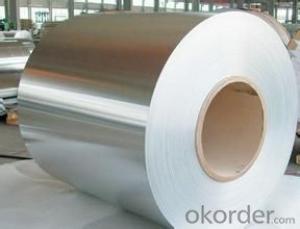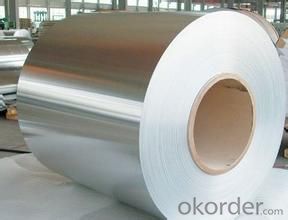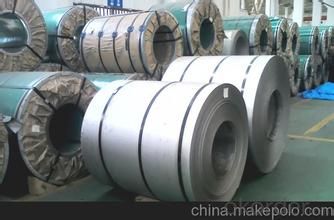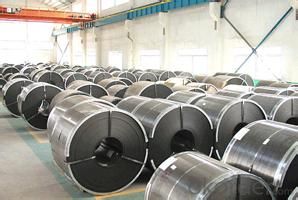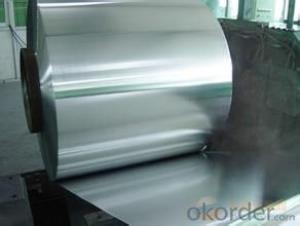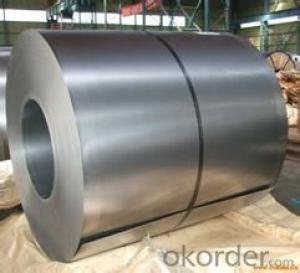Excellent Cold Rolled Steel Coil/Sheet -SPCCT-SB
- Loading Port:
- Tianjin
- Payment Terms:
- TT OR LC
- Min Order Qty:
- 30 m.t.
- Supply Capability:
- 5000000 m.t./month
OKorder Service Pledge
OKorder Financial Service
You Might Also Like
Specification
COLD ROLLED STEEL | |
Thicknenss | 0.10mm-4.00mm |
Width | 600mm-2000mm |
Sheets length | 1200-6000mm |
Coil inner diameter | 508-610mm |
Surface treatement | matt finish/bright finish,oiling/dry, bright anneal/black anneal |
Coil weight | 3-5t |
General Application of Cold Rolled Steel Coil:
1. Refrigerators, cabinets, power distribution baords and drums.
2. Automobile floor and roof panels.
3. Automobile fenders and quarter panels
4. Automobile fenders and quarter panels
Advantage
1. High Quality SurfaceFinish
2. High Dimensional Precision
3. Excellent mechanicalproperty
Package & Delivery
Package details: Standardseaworthy packing for international delivery.
Delivery: According to theexact quantity of your order.
Quality of the goods could be guaranteed. The finished product has a variety of excellent capabilities, such as continuous rolling, degreasing, annealing, skin pass, slitting and cut to length line etc. Along with it many rocessing capability and smooth, flat surface. It’s widely used in outdoor and interior decoration, furnishing.
- Q: How do steel coils contribute to sustainability efforts?
- There are several ways in which steel coils contribute to sustainability efforts. Firstly, steel is a material that can be recycled and reused multiple times without losing its quality or strength. This reduces the need for virgin steel production, which is a process that requires a lot of energy and has a negative impact on the environment. By incorporating recycled steel coils into manufacturing processes, companies can significantly reduce their carbon footprint and conserve natural resources. In addition, steel coils are known for their long lifespan and durability. This means that products made using steel coils, such as automotive parts, construction materials, or appliances, also tend to last longer. This reduces the need for frequent replacements, which in turn reduces waste generation and conserves resources. Moreover, advanced technologies can be used to manufacture steel coils in a more energy-efficient way, resulting in reduced greenhouse gas emissions. Steel manufacturers are increasingly adopting sustainable practices, such as using energy-efficient furnaces, optimizing production processes, and implementing recycling initiatives. These measures help minimize the environmental impact of steel production and contribute to overall sustainability efforts. Furthermore, steel coils are widely used in the construction industry, which plays a vital role in sustainable development. Steel is a crucial component in the construction of energy-efficient buildings and infrastructure, such as green buildings and renewable energy projects. These structures are designed to minimize energy consumption, reduce emissions, and promote resource efficiency. By using steel coils in these sustainable construction projects, the industry can contribute to a greener and more sustainable future. In conclusion, the recyclability, durability, energy-efficient manufacturing processes, and role in sustainable construction make steel coils a valuable contributor to sustainability efforts. By choosing steel coils and promoting their use, companies and industries can reduce their environmental impact, conserve resources, and contribute to building a more sustainable society.
- Q: When and where did soldiers wearing steel protective helmets start ?It seems to have been common by the start of WW1
- They used to wear entire steel suits of armor in the middle ages. They stopped wearing the armor with the invention of reliable firearms, but steel helmets have been around since then. Before that, they wore iron or bronze helmets. Some armies went to a soft cap through the mid 1800s until fragmentary type artillery rounds appeared. Then helmets started coming back again. WWI was the big return.
- Q: What is the average lifespan of a steel coil?
- Several factors can influence the average lifespan of a steel coil. These factors encompass the quality and type of steel utilized, the conditions in which the coil is stored or used, and the maintenance and care it receives. Typically, a steel coil that is well-maintained can endure for approximately 10 to 30 years. Nevertheless, this is merely an approximation, and the actual lifespan can be either shorter or longer depending on the aforementioned factors. For example, if the coil is exposed to severe environmental conditions, such as extreme temperatures or corrosive elements, its lifespan may be diminished. Regular upkeep and proper storage can significantly prolong the longevity of a steel coil. This entails ensuring that the coil is stored in a dry and safeguarded environment, frequently inspecting and addressing any indications of corrosion or damage, and conducting routine cleaning and lubrication as necessary. Ultimately, the average lifespan of a steel coil is contingent upon various factors, and it is advisable to consult the manufacturer or industry experts for a more precise estimation based on specific circumstances and conditions.
- Q: What are the different types of steel coil surface treatments for indoor applications?
- There are several different types of steel coil surface treatments that are suitable for indoor applications. These treatments are designed to enhance the appearance, durability, and performance of the steel coil in various indoor environments. Some of the common surface treatments for indoor applications include: 1. Galvanized Coating: This is one of the most popular surface treatments for indoor applications. Galvanizing involves applying a layer of zinc to the steel coil, which provides excellent corrosion resistance and protects the steel from environmental elements. 2. Pre-painted Coating: Pre-painting the steel coil with a specific color or finish is another common surface treatment for indoor applications. This coating not only improves the aesthetics of the steel, but also provides additional protection against corrosion and wear. 3. Powder Coating: Powder coating is a process where a dry powder is electrostatically applied to the steel coil and then cured under heat. This treatment creates a durable and attractive finish that is resistant to chipping, scratching, and fading. Powder coating is available in a wide range of colors and textures, making it a versatile choice for indoor applications. 4. Vinyl Coating: Vinyl coating is a type of surface treatment that involves applying a layer of PVC (polyvinyl chloride) to the steel coil. This coating provides excellent chemical resistance and protects the steel from moisture, abrasion, and UV radiation. Vinyl coating is commonly used in indoor applications where chemical exposure or moisture resistance is a concern. 5. Laminated Coating: Laminating the steel coil involves bonding a thin layer of plastic or other material to the surface of the steel. This treatment enhances the appearance of the steel and provides additional protection against scratches, stains, and fading. Laminated coatings are available in various colors and patterns, making them suitable for indoor applications where aesthetics is a priority. It is important to consider the specific requirements of the indoor application when choosing a steel coil surface treatment. Factors such as corrosion resistance, durability, aesthetics, and budget should be taken into account to ensure the best possible performance and longevity of the steel coil in indoor environments.
- Q: How are steel coils labeled for identification?
- Steel coils are typically labeled for identification using a combination of unique alphanumeric codes, barcodes, or labels that include important information such as the coil's dimensions, weight, grade, production date, and supplier details.
- Q: What are the common applications of pre-painted galvanized steel coils?
- Pre-painted galvanized steel coils have a wide range of applications across various industries. Some of the common applications include: 1. Construction: Pre-painted galvanized steel coils are extensively used in the construction industry for roofing, wall cladding, and structural components. The coating on these coils provides excellent corrosion resistance and durability, making them suitable for both residential and commercial buildings. 2. Automotive: These coils are also widely used in the automotive industry for manufacturing parts and components such as body panels, interior trims, and underbody protection. The pre-painted coating enhances the aesthetic appeal of the vehicles while providing protection against rust and corrosion. 3. Appliances: Pre-painted galvanized steel coils are commonly used in the production of home appliances such as refrigerators, ovens, washing machines, and air conditioners. The smooth and durable coating on these coils ensures a long-lasting and visually appealing finish for the appliances. 4. Furniture: The pre-painted galvanized steel coils find application in the furniture industry for manufacturing cabinets, shelves, and other furniture components. The coating on these coils adds a decorative touch to the furniture while offering protection against scratches and wear. 5. Electrical and Electronics: These coils are utilized in the electrical and electronics industry for manufacturing switchboards, control panels, and enclosures. The pre-painted coating provides insulation and protection against electrical hazards, making them suitable for such applications. 6. Agricultural Equipment: Pre-painted galvanized steel coils are also used in the agricultural sector for manufacturing equipment like grain silos, livestock shelters, and poultry houses. The corrosion-resistant coating on these coils ensures the durability and longevity of the agricultural structures. 7. Signage and Advertisement: The vibrant and visually appealing colors of pre-painted galvanized steel coils make them a popular choice for signage and advertisement boards. The coated surface provides a smooth and glossy finish that enhances the visibility and attractiveness of the signage. In summary, the common applications of pre-painted galvanized steel coils include construction, automotive, appliances, furniture, electrical and electronics, agricultural equipment, and signage and advertisement. These coils offer excellent corrosion resistance, durability, and aesthetic appeal, making them suitable for a wide range of industries and applications.
- Q: How are steel coils used in the petrochemical industry?
- Steel coils are commonly used in the petrochemical industry for various applications such as manufacturing pipes, tanks, and pressure vessels. They serve as raw materials for fabricating these essential components used in the transportation, storage, and processing of petrochemical products. The strength and durability of steel make it an ideal material for withstanding harsh environments and high-pressure conditions, ensuring the safety and efficiency of petrochemical operations.
- Q: How are steel coils used in the production of medical equipment?
- Steel coils have various applications in the manufacturing of medical equipment. One way they are commonly used is in the production of surgical instruments. Scalpels, forceps, and clamps, for example, require a cutting edge that is both sharp and long-lasting. Steel coils are ideal for creating these edges as they can be easily shaped, hardened, and sharpened, ensuring precision and durability. Furthermore, medical devices like braces, orthopedic implants, and prosthetics often incorporate steel coils. These devices necessitate materials with exceptional strength and durability to provide support and stability to the body. Steel coils can be molded into different forms and sizes to meet the specific needs of patients, delivering the required support and functionality. Moreover, steel coils find application in the manufacturing of medical equipment such as MRI machines and X-ray systems. These machines rely on robust and dependable components to guarantee accurate imaging and diagnostics. Steel coils are integral to the construction of these machines as they provide stability and structural support, enabling precise and high-quality imaging. To summarize, steel coils are of utmost importance in the production of medical equipment as they offer strength, durability, and versatility. Whether it's surgical instruments, orthopedic devices, or diagnostic machines, steel coils are utilized to create dependable and high-performing medical equipment that ultimately enhances patient care and outcomes.
- Q: I'v had 5 people at school say steel is stonger than Titanium and some(5) kids at school say titanium stronger then steel but i looked it up on the internet and i got soem web sites that say steel is stronger then titanium and some sites that say titanium is stonger then steel sooooo???? witch one is strongerPS i no tungsten is stronger then steel.... and titanium.................
- Titanium has better high temperature strength than steel. Titanium doesn't resist shocks like steel can. It's more brittle. It's also far more difficult to weld. Titanium must be welded in an oxygenless environment. The average strength of steels that are made is under that of titanium. However, the strongest steel is stronger than the strongest titanium. Steel is the only viable building material. Titanium is too rare, expensive, and hard to handle for structures of great height. Hope this helps. Peace and Love.
- Q: What are the safety precautions to be followed while handling steel coils?
- To prevent accidents and injuries when dealing with steel coils, it is crucial to adhere to specific safety measures. Here are some safety measures that must be observed: 1. Personal Protective Equipment (PPE): Always wear suitable PPE, including safety glasses, gloves, steel-toed boots, and hard hats. These items serve to shield you from potential dangers such as falling objects, sharp edges, and chemicals. 2. Proper Lifting Techniques: Employ correct lifting techniques to avoid strains and back injuries. Lift using your legs, not your back, and refrain from making sudden or twisting movements while handling the coils. If the coils are excessively heavy or cumbersome to lift manually, resort to mechanical lifting equipment such as forklifts or cranes. 3. Secure Storage: Ensure that steel coils are stored securely and stably to prevent them from falling or rolling over. Make use of appropriate racks, shelves, or storage containers specifically designed for steel coils. Keep the storage area clean, organized, and devoid of obstructions. 4. Handling Tools: Utilize appropriate handling tools like coil hooks, lifting clamps, or coil tongs to firmly grasp the steel coils. Avoid using makeshift or improper tools, as they can cause the coils to slip, leading to accidents. 5. Secure Transportation: Prior to transporting steel coils, ensure that they are adequately secured on the truck or flatbed. Utilize suitable tie-downs, straps, or chains to prevent the coils from shifting or falling during transit. Adhere to all transportation regulations and guidelines to ensure safe transportation. 6. Awareness of Surroundings: Maintain awareness of your surroundings and the presence of other workers or equipment in the vicinity. Keep a safe distance from moving machinery, forklifts, or other vehicles to avoid collisions or accidents. 7. Hazard Communication: Train all employees handling steel coils on proper safety procedures and ensure that they comprehend the potential hazards involved. Display safety signs or labels to indicate the presence of heavy loads or hazardous materials. 8. Regular Maintenance: Regularly inspect and maintain equipment such as lifting devices or storage racks to ensure they are in proper working condition. Promptly report any defects or malfunctions to the relevant personnel for repairs. By adhering to these safety precautions, the risk of accidents, injuries, and damage when handling steel coils can be minimized. Prioritizing safety in the workplace is crucial to safeguarding yourself and your colleagues.
Send your message to us
Excellent Cold Rolled Steel Coil/Sheet -SPCCT-SB
- Loading Port:
- Tianjin
- Payment Terms:
- TT OR LC
- Min Order Qty:
- 30 m.t.
- Supply Capability:
- 5000000 m.t./month
OKorder Service Pledge
OKorder Financial Service
Similar products
Hot products
Hot Searches
Related keywords
